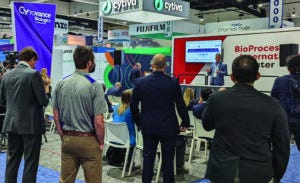- Sponsored Content
- Gene Therapies
Platform Processes Accelerating AAV Vector Production from Gene to ClinicPlatform Processes Accelerating AAV Vector Production from Gene to Clinic
August 24, 2022
Sponsored by Catalent
 Tom VanCott, PhD, global head of product development, Catalent Biologics.
Tom VanCott, PhD, global head of product development, Catalent Biologics.
VanCott emphasized the difficulty of manufacturing cell and gene therapies, noting the large demands for such products from both companies and patients. Manufacturing complexities include the need for raw materials — plasmids, DNA, viral vectors, and cells. Not only is scale-up difficult, but current supply-chain interruptions are slowing access to reagents, media, and disposable bags and resins. VanCott described Catalent’s approach to accelerating delivery of cell and gene therapy treatments to patients.
He noted the need to platform the complex, integrated processes of making the cell and gene therapies. To build the needed infrastructure and teams, Catalent purchased Paragon in 2019 and diversified its viral vector portfolio. At the same time, Catalent scaled up and developed commercial good manufacturing practice (GMP) manufacturing for viral vectors, becoming the first FDA-licensed contract development and manufacturing organization (CDMO) to manufacture a gene therapy on site.
To address the current shortage of — and maintain control over — high-quality, good manufacturing practice (GMP) plasmids, Catalent brought plasmid manufacturing in house through acquisition of Delphi Genetics (Belgium). Another critical demand has been for inducible progenitor stem cells (iPSCs), and Catalent envisioned using iPSC-derived T cells for its future therapeutics. So the next acquisition was of RheinCell in Dusseldorf, Germany, a company with a research team and technology based in iPSCs. Acquisition of a manufacturing site from Aerotek brought immediate access to commercial, cell-therapy manufacturing capacity in the United States. Catalent therefore has assembled the needed infrastructure: facilities, equipment, and people.
VanCott reviewed the pathway to making these products, noting the company’s goal for interconnected materials and processes to become organic to what Catalent does as a CDMO. The first task was to platform the plasmid process to make such material available to customers quickly.
Three critical steps for platforming a gene therapy process are to establish a reliable, high-quality, GMP plasmid supply; produce cell lines and AAV viral vectors under GMPs; and optimize the transfection process. For producing viral vectors, Catalent’s Maryland site focuses on process development innovations, new platform evaluation, assay development, and global technology transfer. Along with a centralized quality-control (QC) laboratory, by the end of 2022 Catalent will have 18 suites for high-throughput viral-vector manufacturing.
Catalent’s UpTempo Virtuoso platform process for adenoassociated virus (AAV) vectors reduces the drug-product manufacturing timeline from ~18 to nine months — focusing on the most variable parameters. An important next step was to develop a template batch record for faster writing and review. A template can ensure that when a process transfers to a manufacturing facility, operators there see a similar process and can proceed quickly, with fewer deviations and investigations. Catalent also locks in a standardized bill of material through in-stock and inventoried materials and use of qualified vendors and back-up vendors. By combining template records, a simplified supply chain, and truncated process development, the company has cut its timeline for plasmid production in half.
The next task is to focus on the complex steps of cell therapy manufacturing: acquiring cells; preparing, selecting, and modifying them; expanding them; and then formulating and testing them. The current process feeds in plasmids and vectors from the template process, and the company is exploring whether it can bring in iPSCs as a stable supply of cell materials.
VanCott described ongoing activities at Catalent’s sites in Europe and the United States. His key point was that processes need to be run in parallel, not sequentially. For example, if you’re making your plasmid DNA, you initially make a research lot that can be translated immediately to your viral vector process development. While you’re developing your process, you’re making your GMP plasmid cell bank so that by the time you’re ready for a GMP viral vector, you’ve got your GMP-grade plasmid. With a platform plasmid process that will yield the same quality attributes and operate in the same manufacturing mode, research and GMP-grade materials are going to behave similarly, so you don’t need to worry about having to repeat preclinical studies or process development.
Fill out the form below to view the full BPI Theater presentation.
You May Also Like






